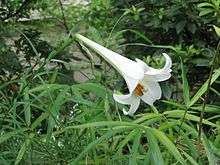Lilium formosanum
| Lilium formosanum | |
|---|---|
 | |
| Scientific classification | |
| Kingdom: | Plantae |
| (unranked): | Angiosperms |
| (unranked): | Monocots |
| Order: | Liliales |
| Family: | Liliaceae |
| Genus: | Lilium |
| Species: | L. formosanum |
| Binomial name | |
| Lilium formosanum Wallace | |
| Synonyms[1] | |
|
Synonymy
| |
Lilium formosanum, also known as the Formosa lily or Taiwanese lily (simplified Chinese: 台湾百合; traditional Chinese: 台灣百合; pinyin: Táiwān bǎihé), is a plant species in the lily family, endemic to Taiwan.[2][3] It is closely related to the Easter lily found in the Ryukyu Islands of Japan, eastern and northern Taiwan. Both species are cultivated for their showy, trumpet-shaped flowers. Lilium formosanum has become naturalized in scattered locations in Africa, Australia, and the Americas.[1]
- Varieties[1]
- Lilium formosanum var. formosanum
- Lilium formosanum var. microphyllum T.S.Liu & S.S.Ying
Names
Several common names for Taiwanese lily are in use among Taiwanese-speaking peoples. These include wild lily (野百合 or 高砂百合), trumpet flower (喇叭花), mountain garlic (山蒜頭 or 山蒜頭 or 山石蒜 or 山蒜瓣), master's flask (師公鈃 or 師公鈃仔花), and so on.[4] It is said the flower has another name of flower of broken bowl (打碗花) form the elderly members of the Hakka ethnic group. They believe that because the Taiwanese lily grows near bodies of clean water, harming the lily may damage the environment, just like breaking the bowls that people rely on.[5] An alternative explanation is that parents convince children into not taking the lily by convincing the children that their dinner bowls may break if they destroy this flower.
References
- 1 2 3 Kew World Checklist of Selected Plant Families
- ↑ Flora of China Vol. 24 Page 147 台湾百合 tai wan bai he Lilium formosanum Wallace, Garden. 40: 442. 1891.
- ↑ Wallace, Alfred Russell 1891. Garden, an illustrated weekly journal of gardening in all its branches 40: 442 description in English
- ↑ "Taiwanese lily 台灣百合" (in Chinese). Archived from the original on 2009-04-16. Retrieved 2010-11-21.
- ↑ Liberty Times (2015). 魯凱六角星,原民聖花 客庄打碗花,生態指標 (in Chinese). 自由電子報.
External links
- Fine Gardening includes photos
- Floridata includes photos
- Invasive Species of South Africa includes photos